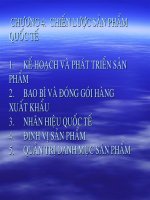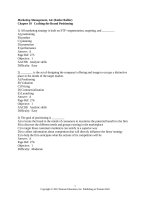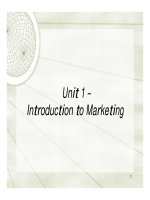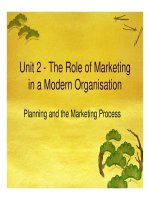Marketing quốc tế Slides BUSM2412 unit 10 s1 08 compatibility mode
Bạn đang xem bản rút gọn của tài liệu. Xem và tải ngay bản đầy đủ của tài liệu tại đây (3.59 MB, 46 trang )
Topic 10
Integrated Marketing
Communications: Advertising,
Sales Promotion, and Public
Relations
1
Road Map: Previewing the Concepts
Discuss the p
process and advantages
g of integrated
g
marketing communication.
Define the five promotion tools and discuss the
f
factors
that
h must be
b considered
id d iin shaping
h i the
h overallll
promotion mix.
Describe and discuss the major decisions involved in
developing an advertising program.
p a how
o sa
sales
es p
promotion
o ot o ca
campaigns
pa g s a
are
e
Explain
developed and implemented.
Explain how companies use public relations to
communicate with their publics.
2
Marketing Communication Mix or
P
Promotion
ti Mi
Mix
Product’s
Design
g
Product’s
Price
Stores that Sell
the Product
Product’s
Package
3
Marketers Have Shifted
Away From Mass
Marketing
Less Broadcasting
2 Factors
are Changing
g g the Face of Today’s
y
Marketing Communications:
Improvement in
Information Technology
Has Led to
Segmented Marketing
More Narrowcasting
Market F
M
Fragmen
ntation Led to
Med
dia Frag
gmentation
The Changing Communications
Environment
4
The Need for Integrated Marketing
C
Communications
i ti
With Integrated Marketing Comm
Communications
nications
(IMC), the Company Carefully Integrates
and Coordinates Its Manyy
Communications Channels to Deliver a
Clear, Consistent, and Compelling
Message About the Organization and Its
Products.
5
Integrated Marketing
C
Communications
i ti
6
Setting the Overall Communication Mix
Advertising
Personal
Selling
S l
Sales
Promotion
Public
Relations
Direct
Marketing
Reaches Many Buyers, Repeats Mes
sage Many Times, Impersonal,
Expensive
Personal Interaction,
Interaction Relationship
Building, Most Expensive Promo
Tool
Wide Assortment of Tools, Rewards
Quick Response, Efforts Short-Lived
V
Very
Believable,
B li
bl Dramatize
D
ti a
Company or Product, Underutilized
Nonpublic Immediate,
Nonpublic,
Immediate Customized,
Customized
Interactive
7
Push versus Pull Promotion Strategy
8
Major Decisions in Advertising
9
Setting
g Advertising
g Objectives
j
g
g
Informative Advertising
Persuasive Advertising
Inform Consumers or
Build Selective Demand
Build Primary Demand
i.e Sony DVD Players
i e DVD Players
i.e
Advertising Objective
Specific Communication Task
Accomplished with a Specific
Target Audience
During a Specific Period of Time
Comparative Advertising
Reminder Advertising
Compares One Brand
Keeps Consumers
to Another
Thinking About a Product
i.e. Apple vs. PC
i.e. Coca-Cola
10
Advertising objectives can be classified by
primary purpose: to inform, persuade, or
remind.
Think of examples
p
of ads that address
each of these objectives.
Using information from the previous slide,
discuss why your examples fit the chosen
objective.
11
Goals and Tasks of Promotion
Informative Objective
Increase awareness
Explain how product works=
Suggest new uses
Build company image
12
Goals and Tasks of Promotion
Persuasion Objective
Encourage brand switching
Change customers’
customers perception of product
attributes
Influence buying decision
Persuade customers to call
13
Goals and Tasks of Promotion
Reminder Objective
Remind customers that product
may be needed
Remind customers where to buy product
Maintain customer awareness
14
The AIDA Model
Model that outlines the process
for achieving promotional goals
in terms of stages of consumer
involvement with the message.
15
AIDA and the Promotional Mix
A
Awareness
I t
Interest
t
D i
Desire
A ti
Action
Advertising
Very
effective
ff ti
Very
effective
ff ti
Somewhat
effective
ff ti
Not
effective
ff ti
Public
Relations
Very
effective
Very
effective
Very
effective
Not
effective
Sales
Promotion
Somewhat
effective
Somewhat
effective
Very
effective
Very
effective
Personal
Selling
Somewhat
effective
Very
effective
Very
effective
Somewhat
effective
16
Factors Affecting the
P
Promotional
ti
l Mi
Mix
Nature of Product
St
Stage
in
i PLC
Target Market Factors
Factors
Aff ti
Affecting
Choice of
Promotional Mix
Type of Buying Decision
Promotion Funds
Push or Pull Strategy
17
Sa
ales ($)
Product Life Cycle and the
P
Promotional
ti
l Mi
Mix
M t it
Maturity
Introduction
Growth
Decline
Time
Light
Heavy use of
Advertising, advertising,
prePR for
introduction awareness;
Publicity
sales
promotion
for trial
Advertising,
PR, Brand
loyalty
Personal
Selling for
distribution
Ads
decrease.
Sales
Promotion
Promotion,
Personal
Selling
Reminder &
Persuasive
AD/PR
decrease
Limited
Sales
Promotion,
Personal
g for
Selling
distribution
18
Target
g Market Characteristics
FOR:
Widely scattered
market
Informed
I f
d buyers
b
Repeat buyers
Advertising
Sales Promotion
Less Personal Selling
19
Type of Buying Decision
Routine
Type of
Buying Decision
affects
Promotional
Mix Choice
Advertising
Sales Promotion
Advertising
Not Routine
or Complex
Public Relations
Complex
Personal Selling
20
Developing Advertising Strategy
Advertising Strategy Consists of Two Major Elements
and Companies are Realising the Benefits of Planning
These Two Elements Jointly.
Creating the
Advertising
Selecting
S
l ti the
th
Advertising Media
Messages
21
Creating the Advertising Message:
Message Strategy
Develop a Message
Focus on
Customer Benefits
Creative Concept
g Idea”
“Big
Visualization or Phrase
Advertising Appeals
Meaningful, Believable
& Distinctive
22
Developing Advertising Strategy:
Message Execution
Testimonial Evidence
Scientific Evidence
Technical Expertise
Slice of Life
Typical
g
Message
Execution
Styles
Personality Symbol
Lifestyle
Fantasy
Mood or Image
Musical
23
Advertising Strategy:
Selecting Advertising Media
Deciding on reach, frequency, and impact.
Choosing among the major media types.
Media habits of target customers,
Nature of the product,
Types and costs of messages
messages.
Selecting specific media vehicles.
Specific media within each general media type.
Deciding on media timing.
Scheduling advertising over the course of a year.
24
Media Types
Newspapers
Magazines
Radio
Television
Major Types
of
Advertising
M di
Media
Outdoor
Internet
Alternative Media
25









